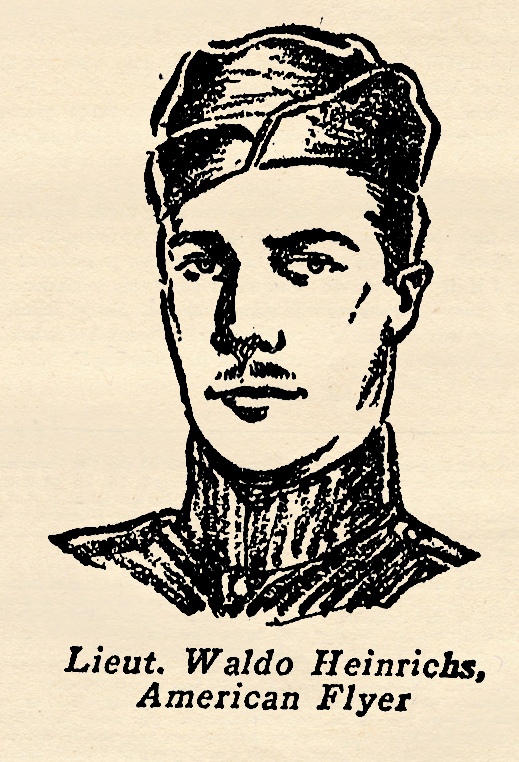My Most Thrilling Sky Flight: Lt. Waldo Heinrichs
Amidst all the great pulp thrills and features in Sky Fighters, they ran a true story feature collected by Ace Williams wherein famous War Aces would tell actual true accounts of thrilling moments in their fighting lives! This time we have American Flyer First Lieutenant Waldo Heinrichs’ most thrilling sky fight!
First Lieutenant Waldo Heinrichs was among  the first contingent of flying cadets to be graduated from the air combat school at Issoudun, France, the great flying field established by the American Air Service on foreign soil after the United States entered the war. He was one of tho original members of the famous 95th Pursuit Squadron, the first American squadron to do actual front line duty with the American Army. Among his squadron mates in the 95th were Lieutenant Quentin Roosevelt and Lieutenant Sumner Sewell.
the first contingent of flying cadets to be graduated from the air combat school at Issoudun, France, the great flying field established by the American Air Service on foreign soil after the United States entered the war. He was one of tho original members of the famous 95th Pursuit Squadron, the first American squadron to do actual front line duty with the American Army. Among his squadron mates in the 95th were Lieutenant Quentin Roosevelt and Lieutenant Sumner Sewell.
No other American flyer ever fought through the hail of bullet fire absorbed by Lieutenant Heinrichs and lived long enough afterward to tell about it in his own words. The account of his last flight as written in his diary is one of the most amazing records of the war. He was shot down and captured by the enemy soldiers on the 17th of September, 1918, after compiling a record of sheer courage second to none.
THE BULLET ABSORBER
by Lieutenant Waldo Heinrichs • Sky Fighters, April 1935
WITH six other pilots from the 95th, I encountered an enemy patrol of nine planes flying at 2,500 meters. Lieutenant Mitchell, the flight commander, signalled for an immediate attack and went down in a dive for the tail of the first German. His guns jammed in the first dive. I followed on the same Fokker he had picked, one of seven which had remained to fight after our attack.
But my guns jammed also, at the first burst!
While zooming up, trying to clear, I fell into a spin. All seven attacked me in my spinning Nieuport. I straightened, hurdled a burst from a forward attacking plane. But the Fokker behind me got in a burst at close range. An explosive bullet hit me in the left cheek, then shattered my windshield. I spit out teeth and blood (16 teeth, I found out afterward). I pulled into a swift renversement, came out beneath the attacker behind.
Two more explosive bullets hit me in the left arm, tearing through, breaking the elbow. Two more broke in my right hand, nearly tore off my little finger. Another hit in the left thigh. One in the left ankle. One in the right heel. Two more hit my leg.
I tried to yank the throttle wide to get more speed. No go! It would not work. The motor died. I saw my arm hanging broken at my side. The blood I spat out
splattered my goggles, blinded me, so I threw them up over my helmet, and dove for the ground. Pulled out just before I crashed into a wood, found a field in front of me, telephone poles. I dove under the wires, fearing they would crash me with a dead motor. The right wing crashed a telephone pole, broke it in two. The Nieuport landed, stopped five feet shy of the field’s edge—in enemy territory!
I broke the gas feed from the wing tank purposely. The gasoline filled the cockpit, sprayed over me. I reached for my matches in the side pocket, to fire the plane. But I was unable to hold anything. I tried to hold the box in my teeth, while I scratched the match, but my whole mouth was blown away.
I did not think to grasp the match box between my knees.
Sixty soldiers with rifles lined on me came running out of the woods. I loosed my belt. As I climbed over the cockpit I saw a pool of blood, my blood, swishing around in the bottom of the pit. I couldn’t run. I had no strength.
I surrendered, holding my right arm up with my left. The German soldiers gave me first aid, applying tourniquets to my left arm and left thigh. But they left me lying there on the field for two hours. Two stretcher bearers came along then and gathered me up. The war was over for me!




